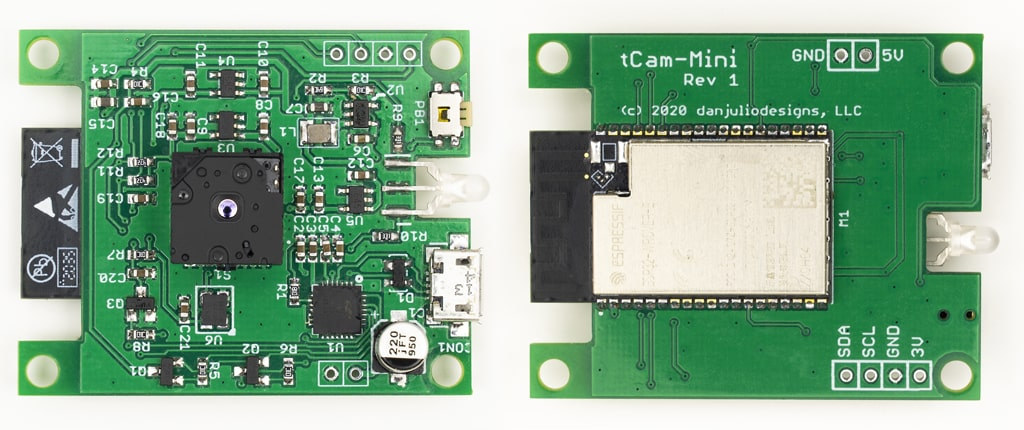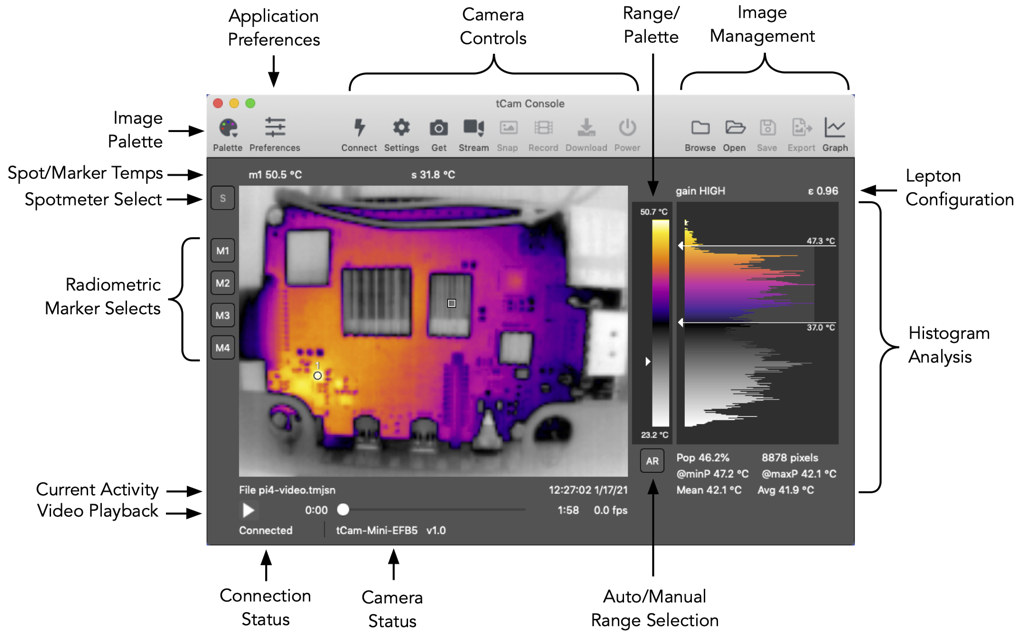While there are plenty of ESP32 camera boards, it’s much harder to find off-the-shelf solutions with ESP32 wireless SoC and an IR thermal camera.
That’s likely why Dan Julio decided to design tCam-Mini board combining an ESP32 module with a Flir Lepton 3.5 sensor with 160×120 resolution to capture radiometric data for thermographic analysis.
tCam-Mini board hardware specifications:
- Wireless module – Espressif ESP32-WROVER-E module with dual-core ESP32-D0WD0V3 WiSoC, 8 MB PSRAM, 8 MB Flash, and PCB antenna;
- Camera – Flir Lepton 3.5: 160×120 pixel radiometric LWIR camera with shutter operating in either Radiometric/TLinear (each pixel contains temperature data) or AGC modes (no temperature data in each pixel but better images).
- Expansion – 4-pin I2C header
- Debugging – Micro USB port with CP2102N-A02 USB to UART bridge for ESP32 boot loader control
- Misc – Dual color (Red/Green) status LED, Factory/Wifi Reset button
- Power supply – 5V input via micro USB port or 2-pin header; 3.3V, 3.0V, 2.8V, and 1.2V output
 It’s possible to connect to the ESP32 thermal camera board in access point or station mode to control it with “tCam console” desktop application compatible with Linux, Mac OS X, and Windows. The application displays images or streams with multiple palettes, saves and loads images or streams with radiometric data, exports images as jpg, png or tiff files, comes with a graphics function to plot spotmeter and marker, export, save or print the graphs for analysis, and so on.
It’s possible to connect to the ESP32 thermal camera board in access point or station mode to control it with “tCam console” desktop application compatible with Linux, Mac OS X, and Windows. The application displays images or streams with multiple palettes, saves and loads images or streams with radiometric data, exports images as jpg, png or tiff files, comes with a graphics function to plot spotmeter and marker, export, save or print the graphs for analysis, and so on.
If you’d rather control the board from your own application a simple json-based command set can be used over a TCP/IP Socket. Both hardware design files (PDF schematics, Gerber files, BoM, etc…) and the ESP-IDF-based firmware source code are available in Dan’s Github repository. The desktop program can also be downloaded from Github but only in binary form.
The tCam-Mini camera board is currently offered for $69.99 plus shipping on GroupGets, but note that the price does not include Flir Lepton 3.5 camera sold as an option for $199.99. The only other ESP32 thermal camera I could find is Seeed Studio’s MLX90621 BAB Thermal Imaging Camera / 16×4 IR Array sold for $129.99 but currently out of stock.

Jean-Luc started CNX Software in 2010 as a part-time endeavor, before quitting his job as a software engineering manager, and starting to write daily news, and reviews full time later in 2011.
Support CNX Software! Donate via cryptocurrencies, become a Patron on Patreon, or purchase goods on Amazon or Aliexpress





Looks a bit fishy.. Leptons are almost always used in combination with a normal RGB camera. Then the images are combined to synthetically make/fake a higher resolution IR image. ex: the flir-one
I don’t think they’re ever used on their own b/c of the minuscule near-useless resolution (thank you ITAR). The example screenshot is seemingly doing that b/c it’s clearly not just 160×120. Also bare in mind that while it nominally 160×120 expect a ton of dead pixels that are also smoothed over in a way that’s hard to detect…
So.. my guess is that the photo of it taking a picture of a candle is faked. Or maybe I’m missing something
[Statement of Bias: I’m backed/ordered the the tcam-mini yesterday]
I don’t think the candle pic was faked, I have a PureThermal 2 usb streaming module with a Lepton 3.5. 160×120 can give a surprising amount of detail, especially when viewing a close object. With the right scaling of the temp levels and the interpolation that goes along with scaling the image up to a viewable resolution the images are surprisingly good
I was able to get a similar image of a birthday candle using the GetThermal tool https://github.com/groupgets/GetThermal using the default settings. With some tweaking of the false color palette using the histogram data, it looks like a reasonable result to me.
I can point the camera at a far wall of a room (maybe 15 feet away) and see an indication studs in the wall if the temperature differential is wide enough. I’ve wondered about fixing the camera’s position and stacking the image to try to remove some of the thermal noise for a better resolution. I’ve never gotten around to it though, since I didn’t want to deal with going from the USB video to a raw feed.
One nice thing about the low pixel count and slow framerate is that even an arduino can keep up with the raw data, so I’m pretty sure that an ESP32 should be able to keep up with managing the camera and streaming the raw data (apparently some kind of JSON formatted data dump, not an actual streaming media protocol). Maybe this will make image stacking easier?
One thing I omitted from my comments about scaling that I should add for completeness:
While scaling the image up and then smoothing it for viewing can result in a very nice image, a user must not forget that the actual radiometric data is still limited to the sensor’s 160×120 resolution. Any use of measured temperatures needs to be planned carefully to make sure the areas of interest are actually being “viewed” by different elements.
If such precision is not required, then image scaling may result in a reasonable interpolation of temperature values.
I haven’t looked at the viewer yet, hopefully, it will allow the user to switch between scaled up version and the raw image. If not, it may not be too difficult to add that feature.
It is important to note that the $69.99 price does NOT include the IR camera itself, which is sold as an “option” for $199.99.
Other thermal cameras include the MLX90640/41/21 (available from Seeed and other sources) and AMG8833 (ditto). They have lower resolution (some as little as 8×8!), but that’s usually more than enough for many applications, and you have many more choices in terms of FOV (field of view) which can be very important for some applications.
Note that since the start of the pandemic, availability is spotty and prices have increased quite a lot…
You can then hook them up to your favorite board, including the gazillions of ESP32 boards, most of which are lot cheaper than then tCam Mini and often include more stuff (Grove connectors for solder less connection to the camera module, more GPIOs, battery circuitry, screens, Ethernet, PoE…).
The UI above is nice, but you can achieve the same thing quite easily with any other board + thermal cam combination. Not sure I understand the point of this specific board at that price point (other than integration of everything on a single PCB), but I may have missed something.
I was impressed by the low price for high resolution until I figured the camera is not in it 🙂
I own an MLX90640 (32×24) connected to my odroid-go which is pretty handy. It is interleaved in chess mode, so you need not to move while taking a snapshot, but that’s quite convenient to find hot spots on a device or to find where cold air enters your hours (or hot air exits). I would love to have double this resolution though, but I don’t think we need a lot for the vast majority of use cases. With 32×24 I can see a complete hand with each individual finger for example.